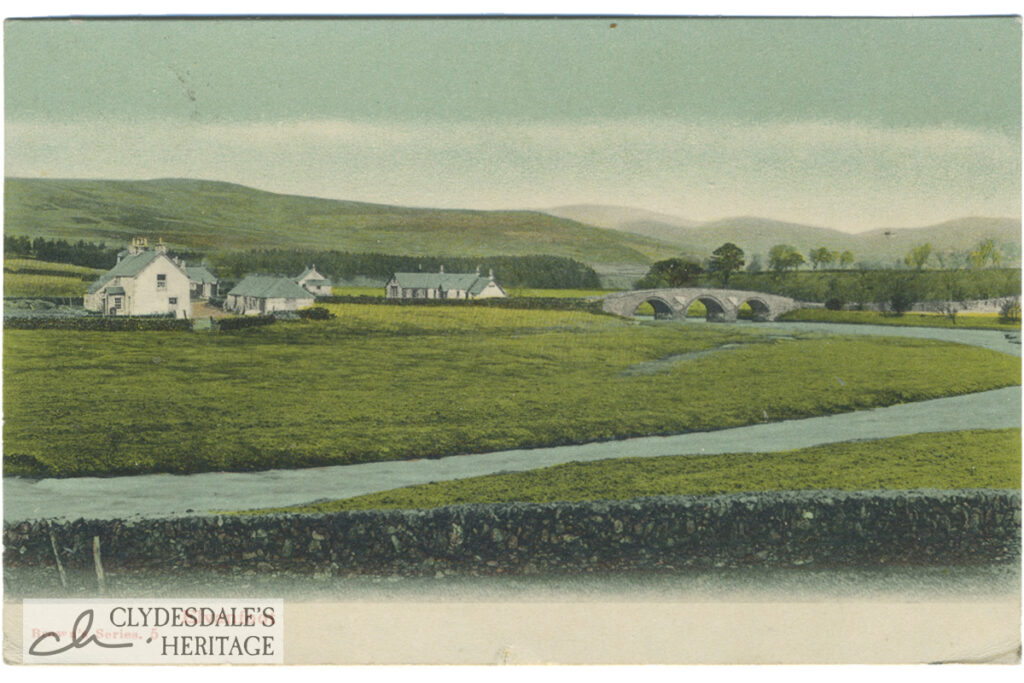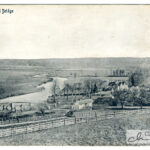In less safety-conscious days, children often played beside (and sometimes in) the River Clyde. In this detail from a postcard from about 1910, youngsters enjoy a paddle in the river at Crawford, a little downstream of the Camps Road bridge.
In 1961 Yuri Gagarin circled the earth, the Beatles first played the Cavern Club, and Jeanie Robertson resumed work on her Book of Memories. Failing eyesight had halted earlier attempts to write her memoirs, however, following a cataract operation at the age of eighty eight she set out again to record memories of her early life. She did this with a beautiful clarity and candour. Amongst these stories were recollections of happy summer holidays spent at Rowantree Cottage during the late 1870’s.
We’ll let Jeanie tell her story…..
Mothers’ folk had farmed in the Lowthers (for over 200 years)…. we grew up to think of the Lowthers as our spiritual home, and the Clyde and its burns the Garden of Eden. … the time came when mother could afford to take Rowantree Cottage, which stood at Clyde side, and each school vacation saw us occupying the long low stone-flagged kitchen with its two box beds, a parlour and best of all a ladder leading up to an attic where the boys slept. This attic had a skylight window and a heap of old junk, and when the boys had misbehaved and a whacking was in store for them, they hauled the ladder up and mother was left ranting in the porch. The cottage was owned by Leezie Macmorran and Tammas her guid man. He had built a lean-to on one side of the kitchen with a fireplace, and here when the cottage was rented out, the couple lived…………. We mostly had a month of the Elysian fields. Yes, we ran wild, barefoot and just about as naked as the day we were born. Our drinking and cooking water had to be carried from a spring nearby which came from the hills and was brown in colour from the peat soils; and talking of peat….oh the glamour of those peat fires! …. we burned nothing else and the fir plantation gave us all the kindling we required……… All conveniences were outside and we all did our ablutions on a three-legged stool from a tin basin which held the Clyde water we were soused in. There was one drawback – we were always hungry. But Leezie would grape up some tatties from her garden and mother would on with a great iron pot and hard boiled eggs and mashed potatoes with plenty of good milk and a bit of butter. This is what we lived and thrived on.
Jeanie goes on to describe some of the games and adventures of those sunny summer days, including one occasion when her brother took to the water in Leezie Mcmorran’s tin washing tub, and narrowly escaped being swept down the Clyde.
While Jeanie doesn’t state the exact location, Rowantree cottage seems to have lay in the old heart of Elvanfoot village, close to the original Clyde bridge. The earliest OS maps show a modest little cottage set in a small garden leading down to the river. A bar across the road outside is marked “Check TP”. It’s hard to believe that prior to 1822, the little road in front of the cottage was the main highway linking Glasgow and England, The cottage may have been built as a toll house, and perhaps continued to control access to the new alignment of the turnpike following construction of Telford’s new bridge across the Clyde.

25″ OS map, c.1855, courtesy National Library of Scotland. Rowantree cottage is in the centre, marked “354”


Postcard view, looking north, showing (from left to right), the former Elvanfoot Inn, rows of cottages, the gable end of Rowantree Cottage, the School, and the old bridge across the Clyde.

Postcard view, most likely taken from the garden of Rowantree Cottage in about 1910. It shows the Old Bridge across the Clyde, Newton House (among the trees and marked with a cross) and the Newton Estate Offices
The 1901 census records Elizabeth and Thomas McMorran as living at “Rowantree cottage”. Although the 1881 and 1891 census show their address as “Elvanfoot Toll”, this presumably referred to the same cottage.

In 1881 Thomas’ occupation is recorded as “shepherd (out of employment)”, and “drainage contractor” in the subsequent census. It seems that was Leezie’s hard work that put most of the food on the table; as Jeanie Robertson explained;
My mother called Tammas a lazy good-for-nothing. Tammas did a bit of draining, but as he said, he had a bad back which no doctor had ever been able to cure and he had to be careful for fear of bringing a fatal ending !

Jean Robertson (nee Millar) is on the right of this family portrait. Her mother Charlotte Millar (nee McMorran, born in Leadhills in about 1845), is in the centre; while on the left is Jeanie’s daughter Sheila Charlotte Chesters (nee Robertson); my grandmother.
Happily Rowantree Cottage survives to this day, one of a little huddle of homes at the end of a narrow road now known as Lodge Cottages, The humble 200-year old cottage has been extended lengthways, widthways and upwards to create a spacious and comfortable home. Surrounded by spectacular scenery and overlooking the majestic Clyde, it’s pleasing to think that future generations can enjoy a childhood spent in this special place.



Rowantree cottage, photographed on a chilly November morning in 2024
Robin Chesters, 23rd November 2024
Unless otherwise stated, all text, images, and other media content are protected under copyright. If you wish to share any content featured on Clydesdale's Heritage, please get in touch to request permission.




